2020 MASERATI GRANTURISMO maintenance
[x] Cancel search: maintenancePage 262 of 286
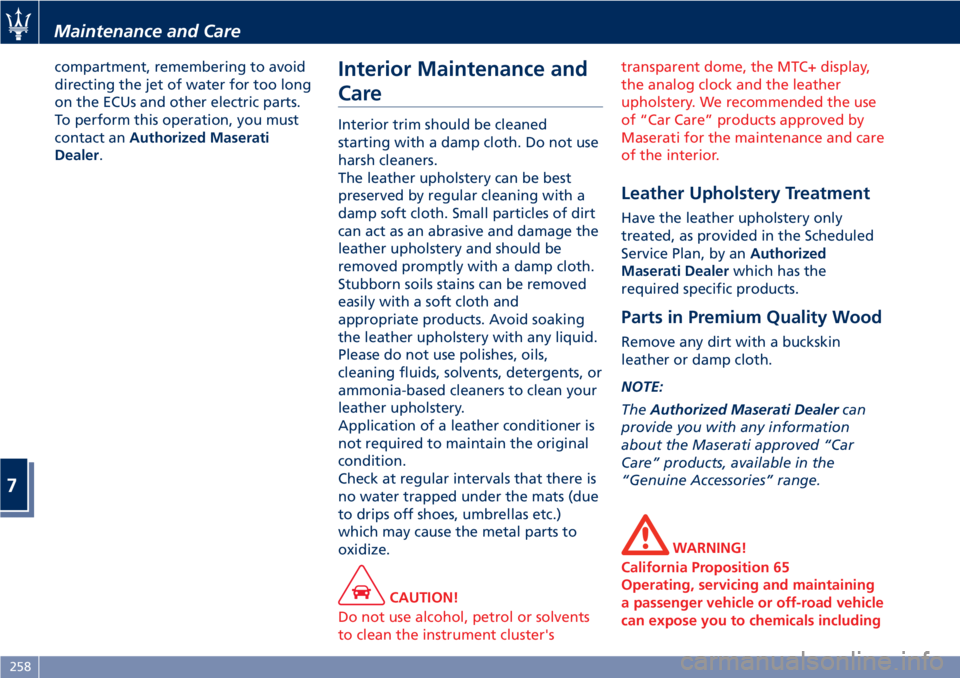
compartment, remembering to avoid
directing the jet of water for too long
on the ECUs and other electric parts.
To perform this operation, you must
contact anAuthorized Maserati
Dealer.Interior Maintenance and
Care
Interior trim should be cleaned
starting with a damp cloth. Do not use
harsh cleaners.
The leather upholstery can be best
preserved by regular cleaning with a
damp soft cloth. Small particles of dirt
can act as an abrasive and damage the
leather upholstery and should be
removed promptly with a damp cloth.
Stubborn soils stains can be removed
easily with a soft cloth and
appropriate products. Avoid soaking
the leather upholstery with any liquid.
Please do not use polishes, oils,
cleaning fluids, solvents, detergents, or
ammonia-based cleaners to clean your
leather upholstery.
Application of a leather conditioner is
not required to maintain the original
condition.
Check at regular intervals that there is
no water trapped under the mats (due
to drips off shoes, umbrellas etc.)
which may cause the metal parts to
oxidize.
CAUTION!
Do not use alcohol, petrol or solvents
to clean the instrument cluster'stransparent dome, the MTC+ display,
the analog clock and the leather
upholstery. We recommended the use
of “Car Care” products approved by
Maserati for the maintenance and care
of the interior.
Leather Upholstery Treatment
Have the leather upholstery only
treated, as provided in the Scheduled
Service Plan, by anAuthorized
Maserati Dealerwhich has the
required specific products.
Parts in Premium Quality Wood
Remove any dirt with a buckskin
leather or damp cloth.
NOTE:
TheAuthorized Maserati Dealercan
provide you with any information
about the Maserati approved “Car
Care” products, available in the
“Genuine Accessories” range.
WARNING!
California Proposition 65
Operating, servicing and maintaining
a passenger vehicle or off-road vehicle
can expose you to chemicals including
Maintenance and Care
7
258
Page 263 of 286
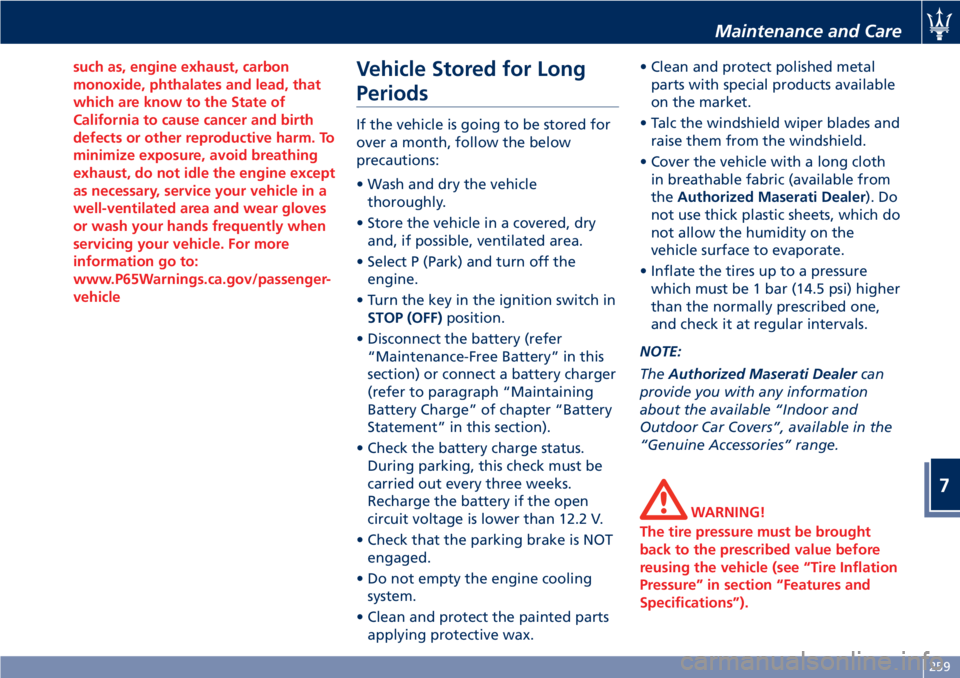
such as, engine exhaust, carbon
monoxide, phthalates and lead, that
which are know to the State of
California to cause cancer and birth
defects or other reproductive harm. To
minimize exposure, avoid breathing
exhaust, do not idle the engine except
as necessary, service your vehicle in a
well-ventilated area and wear gloves
or wash your hands frequently when
servicing your vehicle. For more
information go to:
www.P65Warnings.ca.gov/passenger-
vehicleVehicle Stored for Long
Periods
If the vehicle is going to be stored for
over a month, follow the below
precautions:
• Wash and dry the vehicle
thoroughly.
• Store the vehicle in a covered, dry
and, if possible, ventilated area.
• Select P (Park) and turn off the
engine.
• Turn the key in the ignition switch in
STOP (OFF)position.
• Disconnect the battery (refer
“Maintenance-Free Battery” in this
section) or connect a battery charger
(refer to paragraph “Maintaining
Battery Charge” of chapter “Battery
Statement” in this section).
• Check the battery charge status.
During parking, this check must be
carried out every three weeks.
Recharge the battery if the open
circuit voltage is lower than 12.2 V.
• Check that the parking brake is NOT
engaged.
• Do not empty the engine cooling
system.
• Clean and protect the painted parts
applying protective wax.• Clean and protect polished metal
parts with special products available
on the market.
• Talc the windshield wiper blades and
raise them from the windshield.
• Cover the vehicle with a long cloth
in breathable fabric (available from
theAuthorized Maserati Dealer). Do
not use thick plastic sheets, which do
not allow the humidity on the
vehicle surface to evaporate.
• Inflate the tires up to a pressure
which must be 1 bar (14.5 psi) higher
than the normally prescribed one,
and check it at regular intervals.
NOTE:
TheAuthorized Maserati Dealercan
provide you with any information
about the available “Indoor and
Outdoor Car Covers”, available in the
“Genuine Accessories” range.
WARNING!
The tire pressure must be brought
back to the prescribed value before
reusing the vehicle (see “Tire Inflation
Pressure” in section “Features and
Specifications”).
Maintenance and Care
7
259
Page 264 of 286
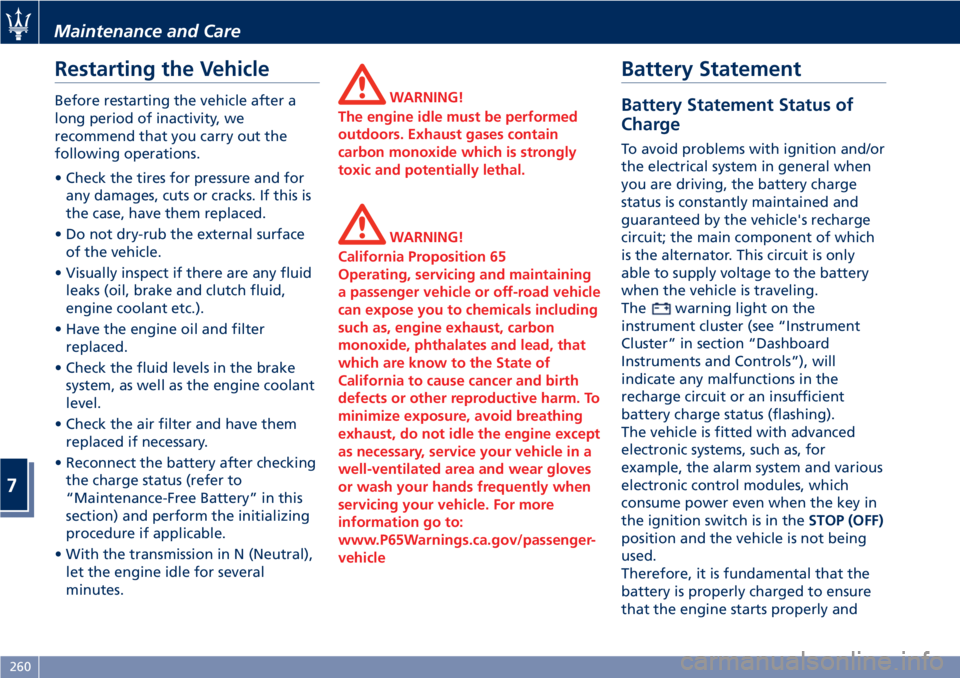
Restarting the Vehicle
Before restarting the vehicle after a
long period of inactivity, we
recommend that you carry out the
following operations.
• Check the tires for pressure and for
any damages, cuts or cracks. If this is
the case, have them replaced.
• Do not dry-rub the external surface
of the vehicle.
• Visually inspect if there are any fluid
leaks (oil, brake and clutch fluid,
engine coolant etc.).
• Have the engine oil and filter
replaced.
• Check the fluid levels in the brake
system, as well as the engine coolant
level.
• Check the air filter and have them
replaced if necessary.
• Reconnect the battery after checking
the charge status (refer to
“Maintenance-Free Battery” in this
section) and perform the initializing
procedure if applicable.
• With the transmission in N (Neutral),
let the engine idle for several
minutes.WARNING!
The engine idle must be performed
outdoors. Exhaust gases contain
carbon monoxide which is strongly
toxic and potentially lethal.
WARNING!
California Proposition 65
Operating, servicing and maintaining
a passenger vehicle or off-road vehicle
can expose you to chemicals including
such as, engine exhaust, carbon
monoxide, phthalates and lead, that
which are know to the State of
California to cause cancer and birth
defects or other reproductive harm. To
minimize exposure, avoid breathing
exhaust, do not idle the engine except
as necessary, service your vehicle in a
well-ventilated area and wear gloves
or wash your hands frequently when
servicing your vehicle. For more
information go to:
www.P65Warnings.ca.gov/passenger-
vehicle
Battery Statement
Battery Statement Status of
Charge
To avoid problems with ignition and/or
the electrical system in general when
you are driving, the battery charge
status is constantly maintained and
guaranteed by the vehicle's recharge
circuit; the main component of which
is the alternator. This circuit is only
able to supply voltage to the battery
when the vehicle is traveling.
The
warning light on the
instrument cluster (see “Instrument
Cluster” in section “Dashboard
Instruments and Controls”), will
indicate any malfunctions in the
recharge circuit or an insufficient
battery charge status (flashing).
The vehicle is fitted with advanced
electronic systems, such as, for
example, the alarm system and various
electronic control modules, which
consume power even when the key in
the ignition switch is in theSTOP (OFF)
position and the vehicle is not being
used.
Therefore, it is fundamental that the
battery is properly charged to ensure
that the engine starts properly and
Maintenance and Care
7
260
Page 265 of 286
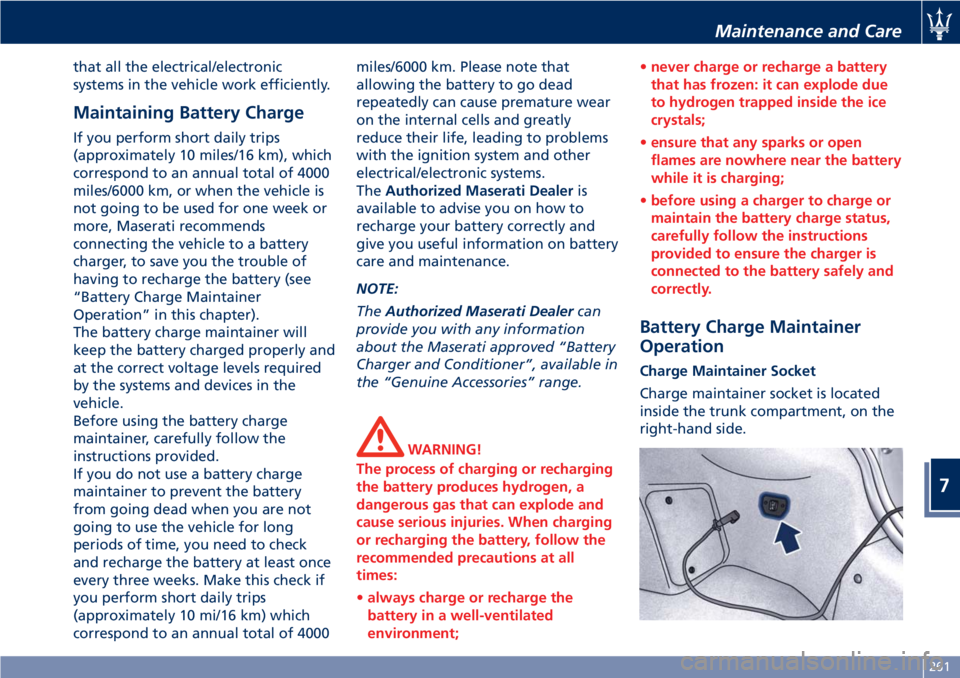
that all the electrical/electronic
systems in the vehicle work efficiently.
Maintaining Battery Charge
If you perform short daily trips
(approximately 10 miles/16 km), which
correspond to an annual total of 4000
miles/6000 km, or when the vehicle is
not going to be used for one week or
more, Maserati recommends
connecting the vehicle to a battery
charger, to save you the trouble of
having to recharge the battery (see
“Battery Charge Maintainer
Operation” in this chapter).
The battery charge maintainer will
keep the battery charged properly and
at the correct voltage levels required
by the systems and devices in the
vehicle.
Before using the battery charge
maintainer, carefully follow the
instructions provided.
If you do not use a battery charge
maintainer to prevent the battery
from going dead when you are not
going to use the vehicle for long
periods of time, you need to check
and recharge the battery at least once
every three weeks. Make this check if
you perform short daily trips
(approximately 10 mi/16 km) which
correspond to an annual total of 4000miles/6000 km. Please note that
allowing the battery to go dead
repeatedly can cause premature wear
on the internal cells and greatly
reduce their life, leading to problems
with the ignition system and other
electrical/electronic systems.
TheAuthorized Maserati Dealeris
available to advise you on how to
recharge your battery correctly and
give you useful information on battery
care and maintenance.
NOTE:
TheAuthorized Maserati Dealercan
provide you with any information
about the Maserati approved “Battery
Charger and Conditioner”, available in
the “Genuine Accessories” range.
WARNING!
The process of charging or recharging
the battery produces hydrogen, a
dangerous gas that can explode and
cause serious injuries. When charging
or recharging the battery, follow the
recommended precautions at all
times:
•always charge or recharge the
battery in a well-ventilated
environment;•never charge or recharge a battery
that has frozen: it can explode due
to hydrogen trapped inside the ice
crystals;
•ensure that any sparks or open
flames are nowhere near the battery
while it is charging;
•before using a charger to charge or
maintain the battery charge status,
carefully follow the instructions
provided to ensure the charger is
connected to the battery safely and
correctly.
Battery Charge Maintainer
Operation
Charge Maintainer Socket
Charge maintainer socket is located
inside the trunk compartment, on the
right-hand side.
Maintenance and Care
7
261
Page 266 of 286
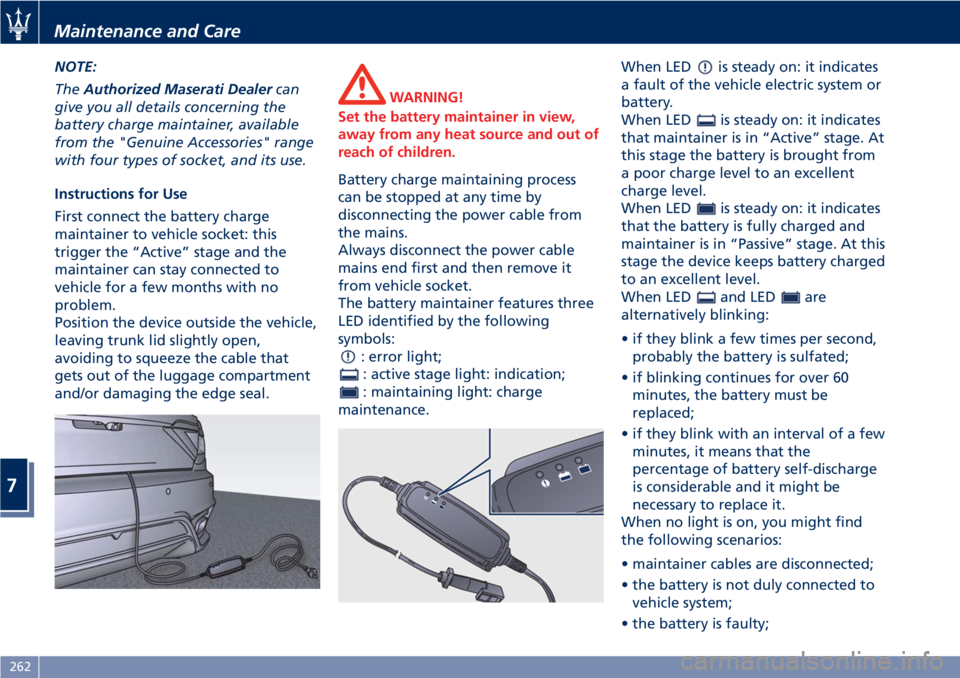
NOTE:
TheAuthorized Maserati Dealercan
give you all details concerning the
battery charge maintainer, available
from the "Genuine Accessories" range
with four types of socket, and its use.
Instructions for Use
First connect the battery charge
maintainer to vehicle socket: this
trigger the “Active” stage and the
maintainer can stay connected to
vehicle for a few months with no
problem.
Position the device outside the vehicle,
leaving trunk lid slightly open,
avoiding to squeeze the cable that
gets out of the luggage compartment
and/or damaging the edge seal.
WARNING!
Set the battery maintainer in view,
away from any heat source and out of
reach of children.
Battery charge maintaining process
can be stopped at any time by
disconnecting the power cable from
the mains.
Always disconnect the power cable
mains end first and then remove it
from vehicle socket.
The battery maintainer features three
LED identified by the following
symbols:
: error light;
: active stage light: indication;
: maintaining light: charge
maintenance.When LED
is steady on: it indicates
a fault of the vehicle electric system or
battery.
When LED
is steady on: it indicates
that maintainer is in “Active” stage. At
this stage the battery is brought from
a poor charge level to an excellent
charge level.
When LED
is steady on: it indicates
that the battery is fully charged and
maintainer is in “Passive” stage. At this
stage the device keeps battery charged
to an excellent level.
When LED
and LEDare
alternatively blinking:
• if they blink a few times per second,
probably the battery is sulfated;
• if blinking continues for over 60
minutes, the battery must be
replaced;
• if they blink with an interval of a few
minutes, it means that the
percentage of battery self-discharge
is considerable and it might be
necessary to replace it.
When no light is on, you might find
the following scenarios:
• maintainer cables are disconnected;
• the battery is not duly connected to
vehicle system;
• the battery is faulty;
Maintenance and Care
7
262
Page 267 of 286
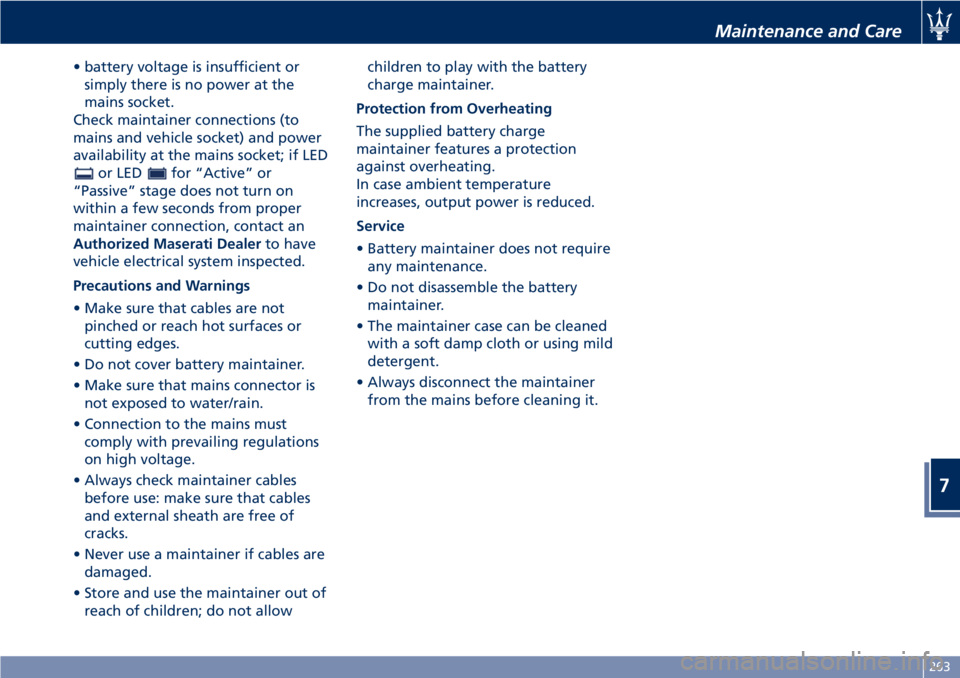
• battery voltage is insufficient or
simply there is no power at the
mains socket.
Check maintainer connections (to
mains and vehicle socket) and power
availability at the mains socket; if LED
or LEDfor “Active” or
“Passive” stage does not turn on
within a few seconds from proper
maintainer connection, contact an
Authorized Maserati Dealerto have
vehicle electrical system inspected.
Precautions and Warnings
• Make sure that cables are not
pinched or reach hot surfaces or
cutting edges.
• Do not cover battery maintainer.
• Make sure that mains connector is
not exposed to water/rain.
• Connection to the mains must
comply with prevailing regulations
on high voltage.
• Always check maintainer cables
before use: make sure that cables
and external sheath are free of
cracks.
• Never use a maintainer if cables are
damaged.
• Store and use the maintainer out of
reach of children; do not allowchildren to play with the battery
charge maintainer.
Protection from Overheating
The supplied battery charge
maintainer features a protection
against overheating.
In case ambient temperature
increases, output power is reduced.
Service
• Battery maintainer does not require
any maintenance.
• Do not disassemble the battery
maintainer.
• The maintainer case can be cleaned
with a soft damp cloth or using mild
detergent.
• Always disconnect the maintainer
from the mains before cleaning it.
Maintenance and Care
7
263
Page 268 of 286
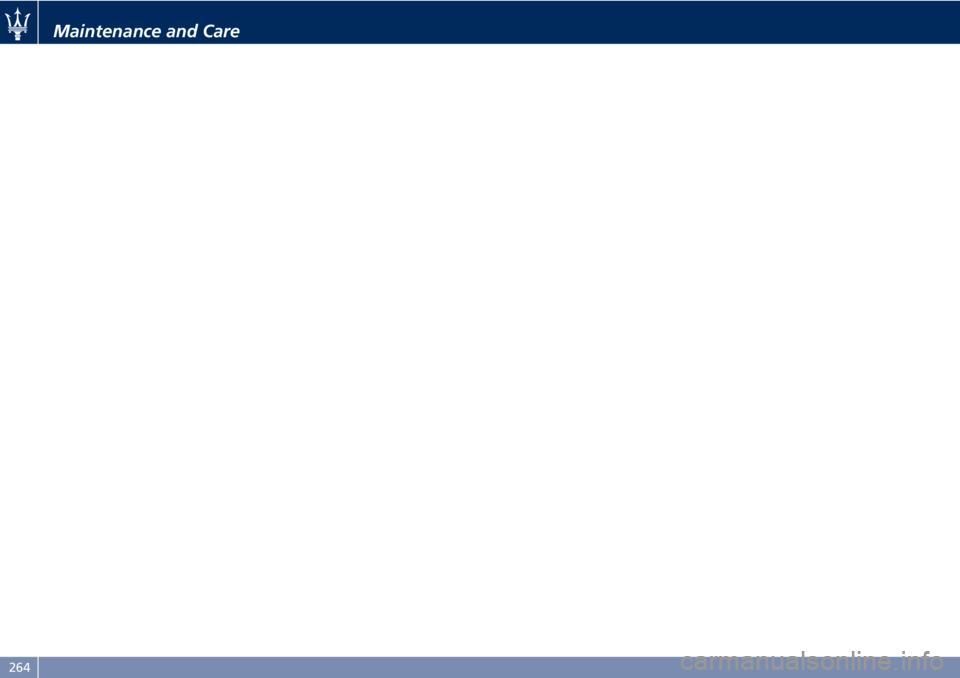
Maintenance and Care
264
Page 272 of 286

WARNING!
California Proposition 65
Operating, servicing and maintaining
a passenger vehicle or off-road vehicle
can expose you to chemicals including
such as, engine exhaust, carbon
monoxide, phthalates and lead, that
which are know to the State of
California to cause cancer and birth
defects or other reproductive harm. To
minimize exposure, avoid breathing
exhaust, do not idle the engine except
as necessary, service your vehicle in a
well-ventilated area and wear gloves
or wash your hands frequently when
servicing your vehicle. For more
information go to:
www.P65Warnings.ca.gov/passenger-
vehicle
Engine Oil Identification
Symbol
This symbol means that the oil
has been certified by the
American Petroleum Institute
(API). Maserati only
recommends API Certified engine oils.
CAUTION!
Do not use chemical flushes in yourengine oil as the chemicals can
damage your engine. Damage caused
by use of non-approved chemicals is
not covered by the new Vehicle
Limited Warranty.
Engine Oil Viscosity (SAE
Grade)
SAE 5W-40 engine oil is recommended
for all operating temperatures.
The engine oil filler cap also shows the
recommended engine oil viscosity for
your engine. For information on
engine oil filler cap location, refer to
chapter “Maintenance Procedures” in
section “Maintenance and Care”.
Lubricants that do not have both the
engine oil certification mark and the
correct SAE viscosity grade number
should not be used.
Fuel Consumption
NOTE:
•The technical data, values and
specifications in this Owner’s Manual
are provided as guidance only. The
vehicle specific data can deviate from
the information provided, for
example, as a result of optional or
special equipment ordered with the
vehicle, vehicle loads, and country
specific measurement methods.
•The specifications described below
can change without prior
notification.
The fuel consumption values shown
(Miles Per Gallon - MPG) are
established using EPA test guidelines.
City:13MPG
Highway:21MPG
Combined:16MPG
Features and Specifications
8
268